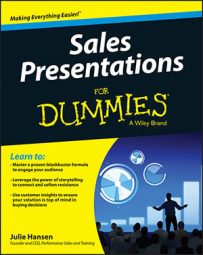Keeping prospect’s engaged during a sales presentation is an ongoing challenge, and you need as many good tools in your toolkit as you can find. Gamification — using elements from game playing, like scoring, rules, and team activity — is a hot topic, especially in e-learning where it’s proven to be extremely effective at helping people learn and retain information. In fact, your prospect has probably participated in some form of game-based training.
Here are a few quick and easy ways to use gamification in your presentation to add variety, increase engagement, and improve your prospect’s ability to recall your message.
-
Develop an interactive agenda. Most presentations are delivered in a very linear fashion with topics delivered in a pre-determined order. If the body of your presentation doesn’t require a sequential structure, in other words, you can start at any point and it still makes sense, give your audience a choice to increase their engagement. Let them decide what the order is by creating a modular agenda. Here’s how:
-
Create an agenda slide and place your topics in a nonlinear order. Use a simple icon for each topic or a one- or two-word description, like “generating reports.”
-
Select the topic that you want to reinforce with your audience and include a prize when it’s selected.
-
Insert a hyperlink on each topic that takes you right to that section in your slide deck.
-
Ask your audience what topic they want to address, click on it, and jump to the topic to begin.
-
Award the prize to the audience member who selects the pre-determined topic.
-
When finished, hyperlink back to the agenda slide and repeat the process until you’ve covered all the topics.
This is a fun way to keep your audience engaged at the start of each topic and give them a sense of actively participating in the unfolding of the presentation.
-
-
Create a real-time poll. Polling your audience on a question that leads into your topic is a great way to get them involved in your presentation early. By adding an element of gamification to it, you make it even more engaging for them. Polls are highly engaging because your audience gets to see how their answer does in comparison to the rest of their group.
Here’s how it works:
-
Get set up in advance with a polling program that allows for text message polling, like www.polleverywhere.com.
-
Develop a poll with a number of choices and assign a unique code to each choice.
-
Create a slide for your poll, clearly displaying the code numbers for each answer and a number for prospects to text their response to.
-
Make sure you have web access for your presentation.
-
Show the poll results in real time on your screen as your audience responds.
-
-
Do a live leaderboard. Great for larger groups (eight or more), this option combines an interactive poll with the concept of a leaderboard because participants compete for a prize and get to see in real time how they stack up next to others. Here’s how to create a leaderboard contest:
-
Come up with a question or topic and solicit answers from three to five audience members.
-
Create a unique code for each audience member’s answer, using your polling program.
-
Ask the group to vote for the best answer by texting the unique code to the number displayed on your screen.
-
Show the results in real time on the screen.
-
Award a prize to the person who receives the most votes.
-
-
This option creates a lot of interest and stimulates healthy competition because participants see how their answers do compared to the rest of the group in real time, whereas also providing some anonymity for their own vote.

